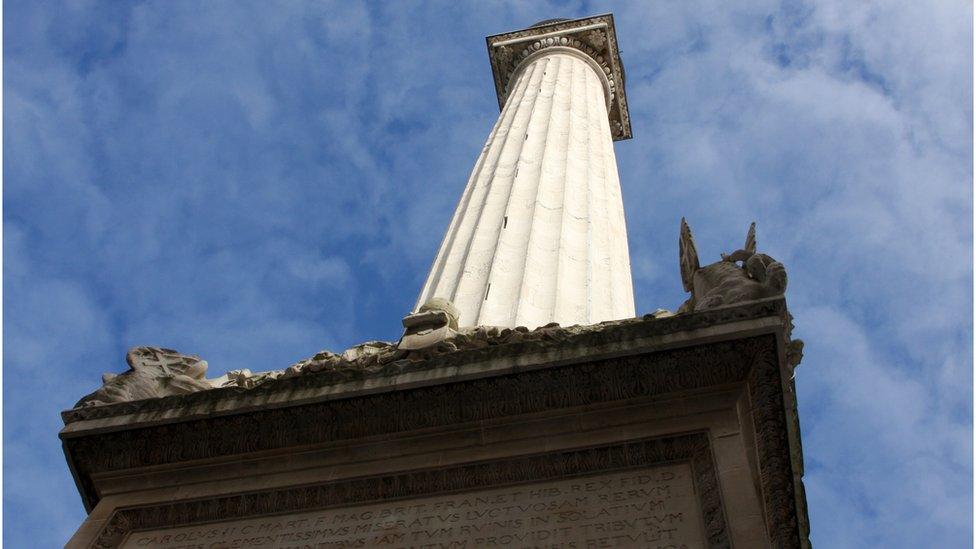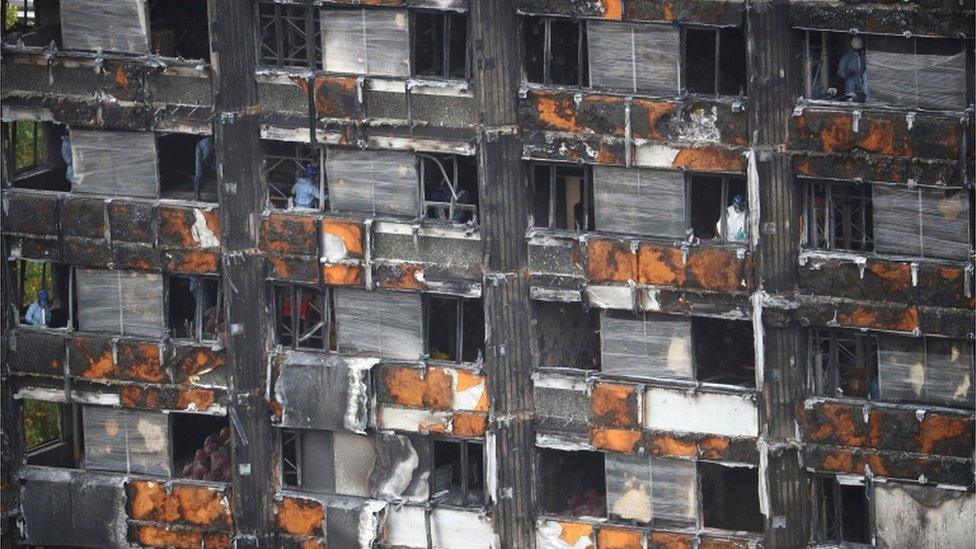Will the building regulation review make buildings safer?
- Published

Monument to the Great Fire of London
Fire safety is an unusual area of public policy, because it is something we have been doing for so long. The state has had building regulations to minimise fire risk since the 13th century - and has been adjusting rules in response to tragedy ever since.
Dame Judith Hackitt's review of building regulations, as they apply in high-rise residential buildings, is a major event in that long history but not a major departure from what went before. In short, it proposes trying to make the existing system work.
Broadly speaking, there are two approaches to building regulation fire safety. One is a "prescriptive" approach, whereby you ban things. That is a type of regulation with a long pedigree. That is, for example, how we responded to the Great Fire of London. In the aftermath of the conflagration, parliament passed a law to govern the materials that could be used in the city:
"Bricke is not onely more comely and durable but alsoe more safe against future perills of Fire. Be it further enacted by and with the Authoritie aforesaid That all the outsides of all Buildings in and about the said Citty be henceforth made of Bricke or Stone or of Bricke and Stone together"
Under Charles II, we responded to the fire with a clear set of standards: "brick or stone walls" is unambiguous. Wood could only be used in doors, windows or shop frontages. The alternative approach is so-called "outcomes-based" regulation. We allow people to make decisions - even using combustible products on tall buildings - so long as they can demonstrate the overall building is safe.

Workers in the Grenfell Tower
Making outcomes-based regulation work
This is not a bad principle, per se. Box-ticking could undermine the process - and rulebooks have to race to keep up with modern engineering. We could not have the skyscrapers and high rises that dot our cities if we had the same 17th century law.
But an outcomes-based approach, as Dame Judith says, requires a much beefier regulatory framework. The task is much more complex than assessing whether a wall is made of brick or stone. There are problems with this process as it stands - and where Dame Judith proposes changes that would apply to high-rise residential buildings:
A new regulator - owned by the Health and Safety Executive, fire services and local authorities - would oversee tall buildings throughout their lives.
The current "Approved Inspector" regime allows building owners to choose the company that will do the building control inspection. She would no longer permit that - the new regulator would do that.
It would be clearer who was responsible for a building's safety at any given moment, so that it is clear who is liable for what.
The new regulator would be able to intervene into the market, commissioning tests and making rulings to get dangerous material off the market.
Her analysis of the lack of clear lines of responsibility and the need for a thicker regulatory layer is likely to go places. A reasonable person can differ, but she makes the case for change. The real questions around that part of the proposals are bureaucratic: her proposal means a two-tier system with rules for high-rises that differ from the rest. That is the kind of thing that may be problematic.

A couple evacuated from a Camden tower block installed with combustible cladding in June 2017
Problems with the package
But there are big areas where she proposes little change. Testing labs are able, at present, to run repeated tests on the same designs. A system can fail nine times - but if it flukes a pass on the 10th occasion, it is allowed onto the market. This can happen because test failures are kept as a commercial secret. She proposes that there should be more transparency but stops a long way short of the transparency required to stop that.
She acknowledges that there is a problem with desktop studies: reports written by a fire engineering company instead of running a test. We revealed how these have been used inappropriately to get around tests. But she does not propose getting rid of them or cut back their use. Her proposal is to clamp down on who can write them - they should be accredited fire lab companies.
But we have reported on concerns about tests by exactly the accredited companies that she would permit to keep writing them. One of them wrote a desktop study predicated on the idea that aluminium panels would behave like ceramic tile in a fire. I am unclear how these proposals would change that.
There is a more fundamental issue, too: academics have also told Newsnight that fire science is not yet advanced enough to permit such reports to be trustworthy.
The big picture
There are parts of the report where I do not think Dame Judith makes her case very well: for example, she argued the problem is "too much prescription". She believes that the number of prescriptive rules within our outcomes-based system are a serious problem.
But there is no reason why you cannot retain an outcomes-based system, but also write in rules that state - for example - that combustible insulation material should not be used on high-rise buildings. That fusion is common. Take GP prescribing. They have freedom over prescribing and are responsible, but there is a "black list" of things that they are not allowed to give to patients.
There is a problem that some of the rules are so badly drafted that they are ambiguous, as I have written before. I would hope that a bigger, better funded regulator might be the answer to that. A major problem in fire safety has been indifference within government. It has taken tragedy to make ministers take it seriously.
The idea that there is a problematic box-ticking culture is hard to substantiate. I would note that checklists are not a bad thing, used wisely. They are how we keep planes safe, for example. And in lots of places, it looks as though the vague professional judgment that a building was safe was used too widely - and there was too little attention to the detail of the regulations.
There is a bigger issue, too. This preference for giving industry responsibility for its decisions sounds fine in the abstract. But if you believe her condemnation of the culture within the building industry, increasing their room for discretion is surely a risk? Would we have argued that bankers needed more room for manoeuvre in 2008?
There is a case, right now, for a bit more Charles II in our regulation. There are calls for bans on types of cladding. Dame Judith's report may not hold that demand back.